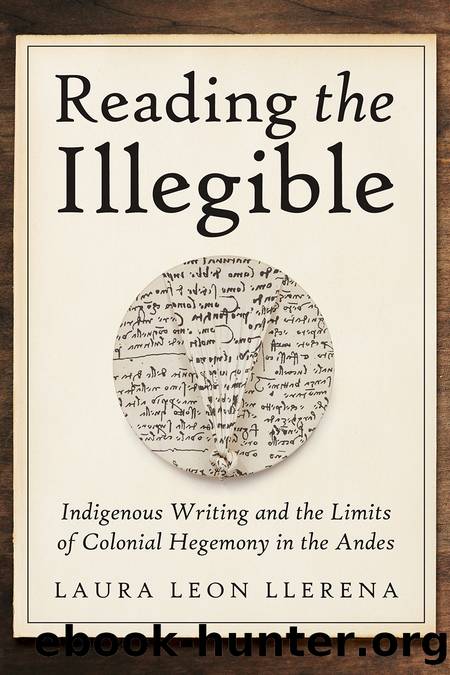Reading the Illegible by Laura Leon Llerena;

Author:Laura Leon Llerena; [Leon Llerena, Laura]
Language: eng
Format: epub
Tags: SOC062000 SOCIAL SCIENCE / Indigenous Studies, HIS033000 HISTORY / Latin America / South America, SOC002010 SOCIAL SCIENCE / Anthropology / Cultural & Social
Publisher: Chicago Distribution Center (CDC Presses)
On Authorship
The authorial attribution of the Huarochirà manuscript continues to be a matter of debate to this day. This final section focuses on the most important hypotheses proposed by scholars in the past decades, and stops to discuss the most recent claim that identifies Cristóbal Choque Casa, an Indigenous ally of Father Ãvila, as the author of the Quechua manuscript. However neatly Choque Casa may seem to fit into our modern expectations of authorship, I argue that the hypothesis becomes implausible once we pay attention to what the anonymous narrator carefully conveys about Choque Casa, and how Ãvila referred to their collaboration.
A marginal note in Spanish that states, âBy the hand and quill of Thomas,â seems to solve quite easily the issue of the Huarochirà manuscriptâs authorship.124 But this seems to have been added well after the creation of the manuscript by a scribe that was practicing his handwriting, much like the case of the anonymous prayer-like note left between the end of the HM and the beginning of Ãvilaâs Tratado y relación, discussed previously.
Whereas the authorship of the Huarochirà manuscript remains an open question, scholars do agree that Father Ãvila was not the author. I will briefly outline the three main paths that scholars have followed regarding the HMâs authorship and the plausible processes of its writing and editing.125 The first line of argumentation posits that an unidentified person of the Checa ethnic group of Huarochirà authored the manuscript, imprinting his point of view as a hint. The differences in size and regularity of the handwriting throughout the thirty-one numbered chapters and the two supplements could indicate that the writing of the manuscript was done in various stages. Whoever penned its chapters did not know Spanish as a first language. The spelling and grammatical errors reveal that this person was more familiar with Quechua than with Spanish.126
A second approach points to marginal notes in the manuscript as evidence that the same person compiled and edited information.127 The third position identifies Cristobal Choque Casa, named in two chapters of the manuscript, as the author.128 Father Ãvila mentioned him in his book of sermons as an ally in the uprooting of idolatrous practices, but we know from the legal dossier discussed in chapter 2 that Choque Casa also intervened in defense of the embattled priest. I agree with the first two approaches, which are complementary, but not with the last one. The attribution of authorship to Choque Casa is based fundamentally on elements that are not entirely convincing: handwriting and a particular interpretation of the chapters of the HM where he is mentioned.
Choque Casa, as discussed before, wrote down a document that compiled recantations from some Huarochirà parishioners that had originally accused Ãvila of a series of offenses. Durston points out that there are enough similarities between the handwriting of that text, the so-called Sunicancha document, and the Huarochirà manuscript to assert that the same person wrote down both. Yet by Durstonâs own account, there are as many similarities as variations between the handwriting of the two texts.
Download
This site does not store any files on its server. We only index and link to content provided by other sites. Please contact the content providers to delete copyright contents if any and email us, we'll remove relevant links or contents immediately.
The Vikings: Conquering England, France, and Ireland by Wernick Robert(79935)
Ali Pasha, Lion of Ioannina by Eugenia Russell & Eugenia Russell(40158)
The Conquerors (The Winning of America Series Book 3) by Eckert Allan W(37149)
The Vikings: Discoverers of a New World by Wernick Robert(36923)
Cecilia; Or, Memoirs of an Heiress — Volume 1 by Fanny Burney(32437)
Cecilia; Or, Memoirs of an Heiress — Volume 2 by Fanny Burney(31873)
Cecilia; Or, Memoirs of an Heiress — Volume 3 by Fanny Burney(31857)
Empire of the Sikhs by Patwant Singh(22978)
The Secret History by Donna Tartt(18852)
Hans Sturm: A Soldier's Odyssey on the Eastern Front by Gordon Williamson(18486)
Cat's cradle by Kurt Vonnegut(15189)
Pimp by Iceberg Slim(14398)
Sapiens: A Brief History of Humankind by Yuval Noah Harari(14254)
Talking to Strangers by Malcolm Gladwell(13229)
Norse Mythology by Gaiman Neil(13211)
Leonardo da Vinci by Walter Isaacson(13189)
4 3 2 1: A Novel by Paul Auster(12289)
Underground: A Human History of the Worlds Beneath Our Feet by Will Hunt(12027)
The Radium Girls by Kate Moore(11930)
